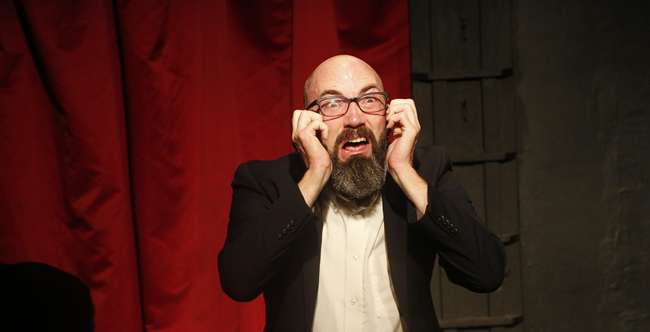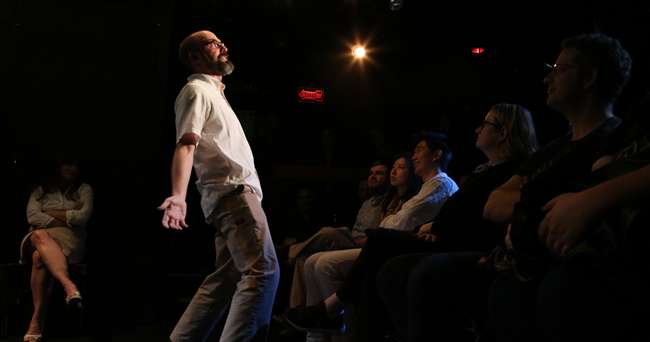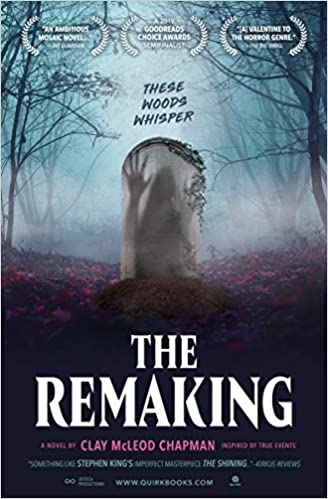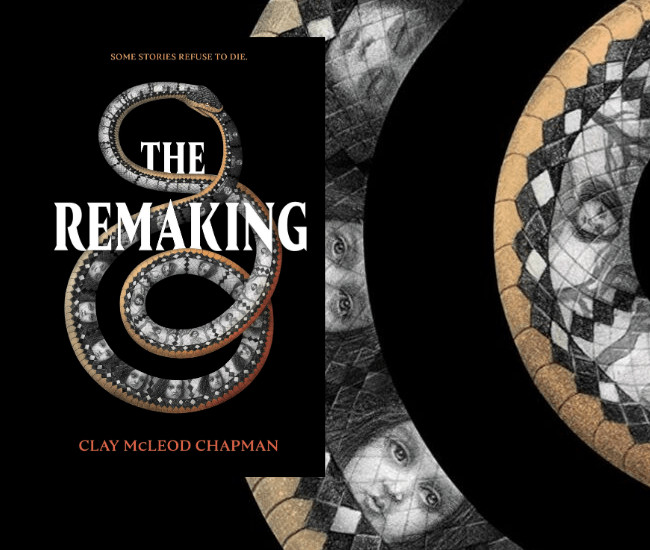The Remaking by Clay McLeod Chapman
When Clay McLeod Chapman and Quirk Books Editorial Director Jhanteigh Kupihea were brainstorming ideas for Chapman’s latest novel—a cerebral horror tale about a ghost story haunted by the very ghosts at its narrative core—they decided to anchor the story in an actual urban legend rather than start from scratch.
“We wanted to find a campfire tale that had been whispered around the region,” Chapman says. “Something with a little history still clinging to its ribs.”
The story that fit the bill was the tale of the Little Witch Girl of Pilot’s Knob, a uniquely disturbing legend of a mother and daughter who were accused of witchcraft, dragged from their Kentucky home (Chapman is a Virginia native), and burned at the stake—allegedly in 1916. It’s nearly impossible to suss out the historic facts behind the story, but it casts a long shadow over the Pilot’s Knob Cemetery, where ghost hunters, sightseers and bored teenagers still gather at the grave of Mary Evelyn Ford, who was only five years old at the time of her death. The grave is topped with a concrete slab and enclosed in a fence made of crosses, supposedly to keep the little girl’s angry spirit confined to her plot. According to legend, the mother’s remains were left in an undisclosed location so that the two would forever be kept apart.
“I just found it heartrending,” Chapman says. “But what made their story even more tragic in my eyes was how, decades later, their story had ossified into something far more salacious. Their personal misfortune was turned into a yarn—a spooky story to scare teens who dared each other to sneak into the local cemetery. Even in death, these women couldn’t get a break. Their story would never truly be their own anymore. Justice would never be met for the crimes perpetrated against them, and to add further insult to injury, the very recounting of their tragic end was exploited for something even more lurid. It would never end. So…what did I do? I exploit that tragedy even further for my own selfish means, implicating myself in the process.”
In The Remaking (Quirk Books), Chapman has gently fictionalized the tale—changing names and dates and filling in a backstory of his own imagining—while hewing close to the legend’s broadest strokes. In his version, Ella Louise Ford and her nine-year-old daughter Jessica are murdered by an all-male mob in the town of Pilot’s Creek in October 1931, but their story doesn’t end on that terrible night. Two decades later, their fate has grown into a campfire legend that haunts the town, driving at least one of its tellers to madness. In the 1970s, it metastasizes again and gets its hooks in Amber Pendleton, a child actress who lands the role of Jessica in a low-budget horror movie called Don’t Tread on Jessica’s Grave. The film becomes a cult classic, mostly thanks to a near-tragedy that shuts down the production, leaving Amber’s life forever altered. Amber is drawn into the story of the Ford haunting again when the film is remade in the ’90s, this time with even more devastating results, and yet again in the present day, when a true-crime podcaster decides to uncover the truth about the “cursed” productions. Needless to say, things don’t go as he expects.

“I wanted to explore the evolution of a ghost story through the years,” Chapman says on the novel’s four-part format. “Trace it through several generations as the preferred mode of storytelling changed… I’ve always been taken by Michael Cunningham’s Specimen Days or Neal Stephenson’s Seveneves or even Anne Washburn’s Mr. Burns, a Post-Electric Play, where the reader or audience are tasked with these expansive narratives that attempt to follow a singular thread—a story—over the course of years, decades, even millennia.”
Chapman, a lifelong horror fan, applied a genre-specific twist to the notion of an ever-evolving story: “What if that was a ghost story?” he asked. “What if the story itself were haunted? That really interested me. Could a ghost story contain the very ghost its narrative was centered around? Has there ever been a haunted ghost story? There have been haunted houses, haunted VHS tapes… but a story?”
The story that would become The Remaking first crept up on Chapman in 1998, when the Japanese horror milestone Ringu was released on home video in the US, and then laid a cold hand on his shoulder when Ringu’s American remake, The Ring, hit theaters a few years later. Chapman loved both movies, but he was struck by the strange cultural shift between the original and the remake.

“I quite honestly asked myself, Huh, if Sadako were an actual ghost, I wonder how she’d feel about this reimagining of her own story,” Chapman remembers. “That led me to asking various questions like, Can a ghost be translated from one language to another? Can a ghost travel across oceans if its story does? Can a ghost still haunt people if it’s been appropriated? I couldn’t stop asking myself these kinds of questions, and it became the foundation for The Remaking.”
As Chapman’s haunted legend began to take shape, he needed a character who could act not only as the story’s emotional center but also as its connective tissue, stringing together the various evolutions of his ghost story. That character is Amber Pendleton, the actress whose life becomes inextricably entangled with the story of Ella Louise and Jessica Ford. Throughout Amber’s life, she can never be sure if she’s an actress playing a role, or a vessel for the ghosts she’s portraying.
“Early on, the phrase don’t kill the messenger popped into my head and it really clung to me when I started conceiving of Amber’s character,” says Chapman. “She was, in my mind, an unwitting narrator. Her life intertwines and intersects with Ella Louise and Jessica Ford. Their stories are inseparable.”
Amber’s character is firmly rooted in a long tradition of horror protagonists whose sanity ends up on the chopping block. In the book’s third section, when Amber finally tells her own story, Chapman compares it to “a coked-up, ‘Tell-Tale Heart,’ unreliable narrator mental breakdown.” His other cultural touchstone was “the horror genre’s obsession with hysteria,” a trope explored in Charlotte Perkins Gilman’s “The Yellow Wallpaper” and Shirley Jackson’s We Have Always Lived in the Castle before popping up in horror films such as Let’s Scare Jessica to Death, Carrie, The Haunting of Julia, and Rosemary’s Baby—all titles that Chapman cites as influences.

And while the novel is an obvious valentine to the horror genre, it’s also remarkably clear-eyed about some of the less savory aspects of fan culture. As an adult, Amber pieces together an income by appearing at horror conventions, where she’s frequently unsettled by fans who want a bigger piece of her than she’s prepared to give. The dynamic was inspired by the author’s chance encounter with Milly Shapiro, the young actress who played Charlie in Hereditary.
“Our conversation was brief, but within our chat, we discussed… well, we discussed ‘the cluck,’ ” Chapman says. “Everyone who’s seen the movie knows exactly what I’m talking about. People on the street, if they recognize her from the movie, will either do the cluck themselves or ask her to do it. This cluck, this simple flick of the tongue against the roof of her mouth, will probably haunt her for years to come. It haunted the audience who saw Hereditary, and now it’s being turned back around on her. Now her audience is clucking at her. I just find that, I don’t know… gobsmacking. Can you imagine? She’ll never escape that sound. I have no earthly idea what that level of attention must feel like, day after day. To be thought of as someone you’re not. A role you played. How does Jamie Lee Curtis handle that? Linda Blair? How many clucks will Milly have to endure? I’m not going as far as to say that the character of Amber is based on Milly, but both she and Jamie Lee Curtis were on my mind as I dove into the book.”
While The Remaking is poised to introduce him to his widest audience so far, Chapman is a veteran storyteller whose accomplishments span many mediums. But mainstream notoriety has eluded him so far, in spite of the kind of auspicious beginning most writers can only dream of: a week before he graduated college, Chapman signed a two-book, six-figure publishing deal. His first book was 2002’s rest area, a collection of short stories—“quasi-campfire mono-diatribes,” in Chapman’s words—he’d written throughout his college years.
“There are stories I wrote in that book that were written with the express intent of impressing girls in my freshman dorm,” Chapman recalls. “And someone wanted to actually publish it! Talk about a miracle.”
Two years later Chapman followed that collection with his debut novel, miss corpus. By then, though, he’d learned that one miracle does not a bestseller make.
“I learned there’s the initial miracle of getting your books on the shelves… and then there’s the subsequent miracle of getting them off the shelves, into reader’s hands,” he says. “That second miracle has never really materialized for me. Which is okay. I got two books on shelves, right out of the gates! Those books are my babies. They were written with nothing but love and youth and utter naïveté. I had very little understanding of this industry and that blissful ignorance was met with a decade’s worth of harsh reality.”
Still, Chapman has gone on to build an impressive resume that encompasses stage, screen, and printed page. His horror-infused live storytelling sessions known as The Pumpkin Pie Show have earned lavish praise from the New York Times, which described him as having “the trembling voice of Vincent Price and the sinister presence of Boris Karloff.” Comics fans know him for his work on Marvel titles such as The Amazing Spider-Man and Deadpool, while middle grade readers might remember his Tribe novels, a trilogy launched by Disney Hyperion in 2013. He’s also well-known to horror enthusiasts thanks to his contributions to the audio drama series Tales from Beyond the Pale and the Elijah Wood-produced film The Boy, a chilling yet empathetic portrait of a child sociopath based on a chapter from miss corpus. (Chapman co-wrote the script with director Craig William Macneill.)
He’s currently at work on a project called Wendell & Wild, which will find him teaming with A Nightmare Before Christmas director Henry Selick and Get Out/Us writer-director Jordan Peele. The story is being simultaneously developed as a stop-motion animated feature for Netflix and a novel for Simon & Schuster; Chapman and Selick will co-write the novel and then team with Peele for scriptwriting duties. Chapman hints that he’s also developing other projects with Quirk, and Marvel is bringing him on board for his own ongoing monthly series with Scream: Curse of Carnage, debuting in November.
If there’s any justice, The Remaking will introduce Chapman to a wider audience of readers anxious for the kind of horror tale that claims a little piece of your brain as its own. And if sitting down with the book happens to make the room feel a little colder and the lamplight a bit dimmer—if it even feels like someone very small, with burnt hair and grave-cold fingers, wants to climb into your lap to hear what happens next—that’s all by design.
“Having performed my own quasi-campfire stories in black box theaters here in New York for the last couple decades, I lean into the rhythms of oral tradition,” Chapman allows. “I wrote The Remaking as an incantation. I wanted it to read like a spell. The rhythm of the narrative, the very flow of the text itself, has a lyrical quality in the service of summoning our Little Witch Girl. Reading the book—to yourself or out loud—is a recitation for Jessica. The complicit act of reading this novel is invoking ghosts.”
The Remaking is available for purchase.
Buy this Book!
Amazon




